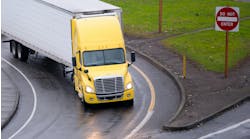NASHVILLE, TN. The current hours of service (HOS) rules are too rigid and need changing so truck drivers can better navigate the vagaries of freight transport, especially traffic congestion. That’s the opinion of two for-hire motor carrier executives – Dean Newell, vice president of safety and training for flatbed fleet Maverick Transportation and Dave Manning, president of TCW Inc. and the currently chairman of the American Trucking Associations (ATA).
Both spoke here during a panel discussion at NATSO Connect; the annual convention of the trade group formerly known as the National Association of Truck Stop Operators. Newell and Manning shared their insights during a discussion chaired by Lisa Mullings, NATSO’s CEO and president, that encompassed a wide range of topics, including autonomous trucks, electric propulsion, and electronic logging devices (ELDs).
In terms of the need for HOS changes, Newell – who said Maverick has been using automatic onboard recording devices or “AOBRDs,” the precursor of ELDs, since 2010 – has found Maverick’s drivers only truly drive 6.5 to 7.5 hours per day out of the 11 hours available to them under their 14-hour on-duty time, with the rest lost to loading/unloading time – one and half hours and two hours on average, respectively – and other delays.
“If we could figure out how to get a half an hour to an hour of more drive time per day, that would go a long way to reducing the driver shortage,” he noted. For example, exiting an interstate to refuel can cost 30 minutes or more to a driver; cutting that down to 15 minutes would return more drive time to a truck operator.
Manning noted that the shift to ELDs is generating some incremental time savings as well, as paper logs only record time increments in 15 minutes, whereas an ELD accounts for every minute. “We’ve found that change saves up to two and half hours per week,” he said.
Yet ELDs and the “rigidity” of the 14-hour clock are creating other difficulties, noted Newell. “The AOBRD would not start recording time until the truck broke 14 mph, but the ELD kicks in at 5 mph,” he said. “So say a driver is parked for the day at a truck stop, but then shifts his truck to allow another vehicle to fit in. He either broke his [14-hour] clock or just started it for the day,” he said.
“That’s an unintended consequence of the HOS rules,” Manning added. “Drivers can’t stop the clock; they can’t wait for traffic congestion to die down. If they spend 45 minutes searching for a parking spot at a truck stop, the ELD is going to capture that. They need more flexibility; especially the flexibility to rest when they need to rest.”
Other topics the two executives addressed during their discussion included:
- Autonomous trucks: “I don’t ever think we’ll see them on the highway,” said Newell. “We’ll them in certain applications, like mining trucks and things like that. But as far over-the-road operation I don’t think we’ll see it in my lifetime. They will be more autonomous, but not driverless; we will still need people in there.” Manning added that drivers “just perform too much other vital work aside from driving,” he explained, citing the tarping down flatbed loads, handling intermodal container exchanges, conducting vehicle safety inspections, and managing hazardous material shipments. “They do way more than simply refuel and drive trucks,” Manning said. “And when does technology work 100% of the time? All systems have flaws and a driver needs to be there to go ‘old school’ in case a problem with the technology occurs.”
- Electrification of trucks: Manning said while electric propulsion is “interesting” because it is quiet and produces no emissions from the truck, to move an 80,000 lbs. tractor-trailer 600 miles would require 20,000 lbs. of batteries. “While I don’t think for a minute that that cannot change, I don’t see electricity being a long-haul solution, though maybe there are regional applications. There are still a lot of obstacles to overcome.” Newell said electricity “will not work” in Maverick’s flatbed fleet, which hauls heavy loads of steel and glass, and “doesn’t see it working” in other more typically over-the-road operations. “It may work in some pickup & delivery fleets but I don’t see it working in our world,” he noted.
- Traffic congestion: Manning highlighted this as a major issue because congestion is so bad right now it creates delays equivalent to 360,000 drivers sitting idle for a year. “We’re short 50,000 drivers now, which is projected to grow to 175,000 in 10 years if current trends hold true,” he explained. “There needs to be more appreciation of the driver’s time and where they lose time.”
- Tolls are a bad idea: Manning said the cost of tolls are prohibitive, with 15% to 35% of toll revenues eaten up by administrative expenses. He is also concerned that if more tolls are deployed on existing roads – “roads we’re already paid for” – that may lead to traffic diverting around them to secondary roads, which are not designed to handle the volume.
- Drivers need more pay and more respect: Both Newell and Manning stressed that pay and home time remain the central elements to recruiting and retaining truck drivers. “Make no mistake; pay and home time are the main things,” said Newell. But pay raises issued by fleets over the course of the last year seems to be improving retention rates. “January is usually the month when [driver] turnover is highest but not this year,” said Manning. “Turnover was almost non-existent for us last month. And we find that most of the turnover occurs in a driver’s first year; if we can keep them for two years, they’ll stay long term.”



